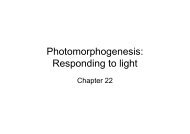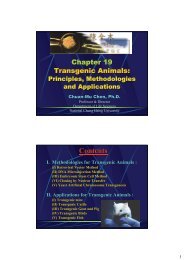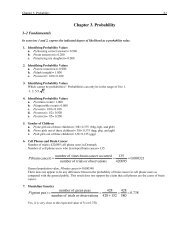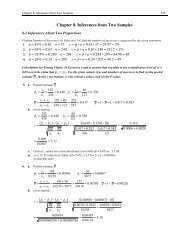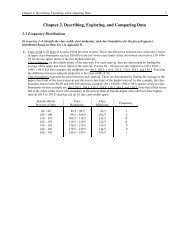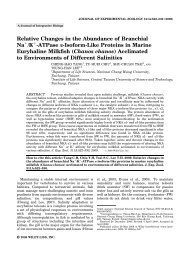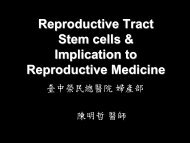Chapter 7. Hypothesis Testing with One Sample
Chapter 7. Hypothesis Testing with One Sample
Chapter 7. Hypothesis Testing with One Sample
Create successful ePaper yourself
Turn your PDF publications into a flip-book with our unique Google optimized e-Paper software.
<strong>Chapter</strong> 7: <strong>Hypothesis</strong> <strong>Testing</strong> <strong>with</strong> <strong>One</strong> <strong>Sample</strong> 221In a right-tailed test at the 0.05 significance level <strong>with</strong> df = 89, we use the degrees of freedom closest to 89,which is 90, and so the critical value is t α= t .05= 1.662.In the row for 90 degrees of freedom, the test statistic falls to the left of 2.632 so the P-value is less than 0.005.We reject the null hypothesis.The sample data support the claim that Norwegian newborn babies, on average, weigh more than 3420g, whichis the mean weight of American newborn babies.22. Conductor Life SpanThe claim is that the mean life span of conductors is greater than 69.5 years, which is the mean life span formales in the general population, so this is a right-tailed test. The sample size is n = 35 making the degrees offreedom df = 34, the sample mean is x = 73.4 , and the sample standard deviation is s = 8.<strong>7.</strong> The significancelevel is 0.05.H 0 : µ = 69.5H 1 : µ > 69.5The test statistic is t = x − µ 73.4 − 69.5=s / n 8.7 / 35 = 2.652In a right-tailed test at the 0.05 significance level <strong>with</strong> df = 34, the critical value is t α= t .05= 1.691.In the row for 34 degrees of freedom, the test statistic falls between 2.728 and 2.441 so the P-value is between0.005 and 0.01.We reject the null hypothesis.The sample data support the claim that the mean life span of conductors is greater than 69.5 years, which is themean life span for males in the general populationYes, it appears they live longer.Since they become conductors at a later age in life, there are most likely other factors that contribute to theirlongevity.23. Poplar Tree WeightsThe claim is that the fertilized trees come from a population <strong>with</strong> a mean weight less than 0.92kg, so this is aleft-tailed test. The sample size is n =5 making the degrees of freedom df = 4. The significance level is notmentioned, and so we use 0.05. Calculating x from the sample data givesx = Σx /n = 1.66 /5 = 0.332Calculating the sample standard deviation from the data givess = nΣ(x 2 ) − (Σx) 225⋅1.8284 − (1.66)= = 0.565n(n −1)5⋅ 4We move on to the test.H 0 : µ = 0.92H 1 : µ < 0.92The test statistic is t = x − µ 0.332 − 0.92=s / n 0.565/ 5 =−2.327In a left-tailed test at the 0.05 significance level <strong>with</strong> df = 4, the critical value is −t α=−t .05=−2.132.In the row for 4 degrees of freedom, the absolute value for the test statistic falls between 2.776 and 2.132 sothe P-value is between 0.025 and 0.05.We reject the null hypothesis.The sample data support the claim that the fertilized trees come from a population <strong>with</strong> a mean weight lessthan 0.92kg.The fertilizer appears to have an effect, decreasing the weight of poplars on site 1.




